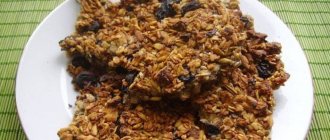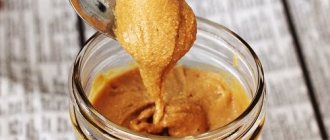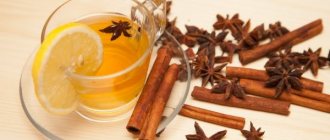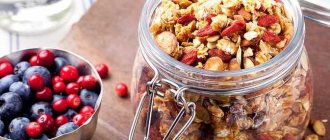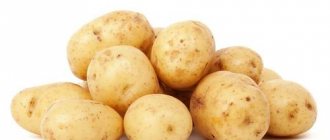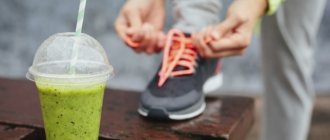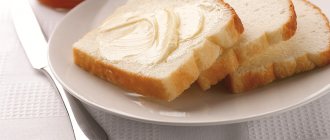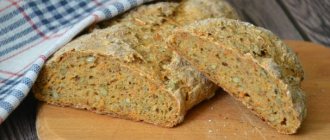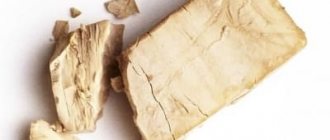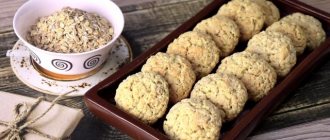Few people today can imagine their life without bread. It is simply impossible to pass by a delicious, aromatic freshly baked product. Nowadays you can find a wide variety of all kinds of baked goods on supermarket shelves. But lately, especially followers of a healthy lifestyle, most often give preference to newfangled yeast-free bread. It is believed that it is much healthier precisely due to the fact that it does not contain yeast. However, is this so? In fact, a striking example of yeast-free bread is dry bread, which is made from whole grains that have retained their shell. Such products contain much more vitamins and useful minerals, since these shells have a particularly valuable composition. Also, when talking about yeast-free bread, we mean a product prepared with natural leaven consisting of flour and water.
Benefits of soda bread
Expert opinion
Recommended!
Bread made without yeast, with sourdough and soda, is aromatic, soft and can replace baked goods with yeast. This product is quickly absorbed by the body, facilitates and speeds up digestion. This baking is coarser than yeast baking and forces the muscles of the intestines and digestive tract to work at an accelerated rate.
Yeast contained in baked goods leads to an imbalance of microflora, and loaves made with bread soda do not have such disadvantages.
In addition, yeast baking causes the accumulation of gases and flatulence due to the accumulation of carbon dioxide in the intestinal pockets.
Also, if you carefully monitor the calorie content of your food, then the soda version has much less sugar and additives than the yeast version.
"Wild" vs industrial
Both “wild” and industrial yeast are of the same species, Saccharomyces cerevisiae. “Wild” ones are present in almost any food - apples, pears, grapes, tomatoes, cucumbers, berries, herbs, cheese, meat, wine, beer, kvass. We also have them in our bodies, along with another 20-30 types of different yeasts. At the same time, Saccharomyces cerevisiae is friendly to the human intestinal microflora - they have an inhibitory effect on pathogenic and opportunistic bacteria.
The difference between industrial Saccharomyces cerevisiae is that they are better suited for baking bread, so they are cultivated artificially. “The technology of bread is such that in semi-finished bakery products (sourdough, sourdough, dough), only selected yeast – baker’s yeast – develops and normally loosens bread,” explains Tatyana Bykovchenko.
Modern bakeries work on three types of baker's yeast: pressed, liquid yeast and sourdough. Often three types are used simultaneously.
Pressed yeast (on the packaging they also say dry / dehydrated, instant / fast-acting) yeast contains only Saccharomyces cerevisiae yeast cells. The main raw material for their cultivation is thick molasses rich in sugars (feed molasses, waste from beet sugar production). It is the main source of nutrition for yeast.
In addition to molasses, yeast needs phosphorus, potassium, nitrogen, magnesium and other trace elements. The unique ability of this product is to synthesize valuable organic substances - proteins, amino acids, enzymes, vitamins, carbohydrates - from inorganic ones. Therefore, for example, ammonium sulfate or aqueous technical ammonia (about 6% in the nutrient medium) is used as a source of nitrogen in yeast production. A source of boron, copper, zinc, molybdenum, iodine, cobalt, manganese for yeast - “microfertilizer for agriculture in the southern regions.”
To acidify the molasses wort and regulate the pH, sulfuric acid is actually used (about 1% in the nutrient medium). Auxiliary materials in production are disinfectants (the same bleach, formalin and Progress liquid detergent), defoamers, water and air.
“At the end of cultivation, before pressing, the yeast is washed from the medium, so the final product, as analysis shows, does not contain either basic or, let alone, auxiliary materials,” explains Tatyana Bykovchenko.
“Almost no industrial microbiological production, be it starter cultures for dairy products or medical preparations (probiotics), can do without the use of chemicals,” the expert adds. “In the production, for example, of dry bioconcentrates for the dairy industry, whey protein concentrates, sodium citrate, calcium carbonate, sodium hydroxide or sodium bicarbonate and others are used.”
Liquid yeast compared to pressed yeast is an improved option close to homemade sourdough. In addition to the yeast cells Saccharomyces cerevisiae, they contain Delbrück's lactic acid bacteria (Lactobacillus delbrueckii). Bread made with such yeast is tastier and more aromatic, does not go stale so quickly, and contains more essential amino acids, vitamins and lactic acid, which is beneficial for our microflora and immunity.
Water buns recipe
There are many recipes for baking, including those without using yeast. But this recipe for real bread without yeast.
For baking you will need:
- wheat flour - 700 g, if you adhere to a healthy lifestyle, then add bran, or take wholemeal flour,
- boiled cold water – 700 g
- sodium bicarbonate - 10 g
- lemon juice - 2 tsp.
Add baking soda to half the volume of flour and mix, leave a glass of water to dilute the lemon juice in it, and pour the rest of the water into the mixture and mix.
We dilute lemon juice in water, add the remaining flour, salt, water and lemon juice to the dough and mix for three minutes. There is no need to stir longer, otherwise it will lose its shape.
Grease a baking sheet with vegetable oil, place the rolled out loaf there and place in the oven, heated to 70 degrees.
Bake at this temperature for 15 minutes, then increase the heat to 220 g and bake for another 50-55 minutes. The golden brown bun is ready to eat.
Is it possible to lose weight on yeast-free bread? The effect of baked goods on the body
Wheat flour contains protein, however, it is incomplete because it does not contain all the essential amino acids. Through the use of yeast, the dough is enriched with B vitamins. Baked goods contain a lot of carbohydrates, mainly starch, as well as minerals. Products made from flour are well absorbed by the body and supply calories and nutrients.
Various types of “bricks” differ in their nutritional value. If the dough is prepared without additives, it will be a source of carbohydrates. If the recipe includes vegetable oil, egg and dairy products, seeds or dried fruits, then such baked goods will have greater nutritional value, will be tastier, and will not go stale so quickly.
Bread is harmful to the body if:
- Eat a lot of it. This affects the figure, causing bloating and constipation.
- The product is too sour. These types of products increase the acidity of gastric juice and are contraindicated for gastritis.
- Lightly baked, viscous, non-porous. In this case, it is poorly absorbed.
- Affected by mold, potato bacillus, and other microbes that cause food poisoning.
The type of flour used makes a big difference. If baked goods are baked using premium raw materials, they contain refined carbohydrates. In the process of grinding white flour, all shells and germ are removed from the grain, and only the central part is used. And almost all minerals and vitamins are found in this “waste”. They turn into flour if it is ground from whole grains. Whole grain bread contains complex carbohydrates and a lot of fiber, so it is digested slowly and provides a feeling of fullness for a long time.
Rye bread is always more sour because, in addition to yeast, a leaven of lactic acid bacteria is added to it. They convert flour sugars into lactic acid. More often, baked goods are prepared using a mixture of rye and wheat flour so that it is not too sour.
Irish bread by Julia Vysotskaya
Popular TV presenter Yulia Vysotskaya, in front of the audience, baked an Irish loaf with soda for breakfast with dried fruits. It is popular for its speed of preparation, benefits and wonderful taste.
For this product prepare:
- Wheat flour with added bran – 500 g,
- Kefir – 450 g,
- Toasted sunflower seeds - optional
- Sodium bicarbonate - 5 g.
Pour salt and soda into the flour, then pour in the kefir and knead into an elastic dough. Add sunflower seeds; they can be replaced with dried apricots or prunes, or other dried fruits to taste.
Recommended for you:
How to make fluffy and delicious pancakes with baking soda at home
Be sure to sprinkle the dough form with breadcrumbs, place the finished bun in it, make two cross cuts on top and bake in an oven preheated to 200 degrees for 45 minutes.
If you are in a hurry, and you have a bread machine on your household, then use its services, then you will always have a freshly baked aromatic loaf for breakfast.
Advantages and disadvantages
Pros:
- has a natural composition: does not contain synthesized ingredients, dyes, preservatives, flavors;
- good for health;
- fits into dietary menus;
- easy to digest;
- long shelf life;
- recommended for baby food.
Minuses:
- unusual taste with sourness;
- there is no usual bread aroma;
- dense consistency, no fluffiness;
- damages gums due to dryness;
- not suitable for those who have dental problems;
- costs more than usual;
- It is difficult and time-consuming to cook at home.
Rye bread
Rye baked goods are tasty and healthy, especially for those watching their weight. To make it you need:
- rye flour -1.5 cups,
- wheat - 1 cup,
- kefir – 1 glass,
- baking soda – 1 tsp,
- equal proportions of sugar, salt and cardamom
Sunflower seeds, pumpkin seeds, raisins or pistachios are added to this dough.
Pour flour into a bowl, add bulk ingredients and pour kefir. Stir and add seeds and dried fruits, mix again. The dough will be elastic but sticky.
Roll out a ball, put it in a mold, pre-greased, and make two or three cuts on top.
Preheat the oven to 220 degrees and place a baking sheet with a loaf of bread there. Sprinkle breadcrumbs on top to make it golden brown.
Bake for 15 minutes, and then lower the temperature to 180 degrees and bake for another quarter of an hour.
We check the readiness of the loaf using a wooden splinter.
This bread can be eaten immediately hot, it is aromatic and fluffy, slightly sweet from dried fruits and has a crispy crust.
White bread calorie content. Dietary properties:
What is the calorie content of white bread, what dietary properties does it have? All this is very interesting for those who are trying to lead a healthy lifestyle and monitor their health and figure. So we will try to answer these questions in the next article.
So here it is:
White bread is made from premium, first or second grade wheat flour. It makes great toast or sandwiches, or you can use it to prepare other dishes. But white bread has a fairly high nutritional value.
Therefore, it definitely cannot be classified as a dietary product. This should be remembered by those who want to lose weight.
White bread is a source of a number of vitamins - vitamins B1, B2 and PP, without which normal functioning of the body is impossible.
Vitamin B1 (thiamine) is needed for the functioning of our nervous system. If there is enough of it, the person is in a good mood and not irritable. Vitamin B2 (riboflavin) is essential for youthful skin, its smoothness and elasticity. And our brain and cardiovascular system need vitamin PP.
It contains calcium, phosphorus, iron. It will hardly come as a surprise to anyone to learn that calcium and phosphorus are the basis for the strength of teeth, bones and nails. It’s not for nothing that children are given products containing these components from an early age. And iron is important for the normal content of hemoglobin in the blood, which is responsible for the transport of oxygen throughout the body. A small amount of hemoglobin is a painful condition - anemia and hypoxia.
Bread without yeast
If you have unused kefir in the house, you can bake a loaf of it without using yeast. It’s easy and quick to prepare, and most importantly, you don’t have to wait for the dough to rise.
Required components:
- kefir - 1 glass,
- oatmeal - 0.5 cups,
- bran (optional) -2 tbsp,
- soda, salt, sugar 1 tsp each,
- flour - 2.5 cups
- honey -1 tsp (for lubrication).
Pour half a glass of kefir over the oatmeal and let it swell, then add the bran. Mix the dry ingredients for the dough in a bowl and pour the kefir and cereal into it.
Mix thoroughly and add the remaining kefir. Knead into a smooth dough.
Grease a baking sheet and place the rolled out dough on it. Make two cuts at the top. Bake for 45-50 minutes in a preheated oven at 200 degrees.
Brush the still hot loaf with honey and sprinkle with sesame seeds, if desired. Let cool without removing from the pan, and then eat.
Yeast-free bread is a myth. The truth about yeast-free bread that not everyone will like
Today we are talking about the benefits of a fashionable product for progressive healthy lifestyles and biohackers - about bread baked using baking powder, sourdough or “wild” yeast.
But first you need to understand why yeast is needed and why everyone bakes with it? It's very simple - yeast converts part of the starch in the dough into gas, which gives fluffiness, and also into protein! But protein is very healthy, because it is necessary!
Thanks to yeast, the bread becomes softer, tastier and more complete in its composition. You can put less cheese/sausage/whatever crap you're cracking it with and still get the same benefits compared to bread that doesn't contain microorganisms. Bonus: B vitamins.
But since everyone eats it, including the French, famous for their longevity and good health, it cannot be fashionable. And gradually, among people far from biochemistry and microbiology, the idea began to spread that yeast is bad. They make them fat, feel tired and make loud noises in the air.
Why is yeast bread so dangerous?
Actually, only the opportunity to accidentally eat an unbaked piece of raw dough with still living baker's yeast, which is harmless to a healthy person.
In fact, educated people do not recommend it only in these cases:
- stomach ulcer
- pancreatitis
- gastritis and gastrointestinal inflammation
Where this yeast may slightly worsen symptoms. But you still need to find a raw piece, because the yeast dies during baking!
Now let’s see what else scares us the degenerates who couldn’t learn biology at school:
Yeast will colonize your intestines, KILLING the “useful” microflora!
The intestinal microbiota is very diverse, capable of self-regulation and is now being actively studied. If you eat fermented milk products, dietary fiber from time to time and don’t rely on antibiotics, everything will be fine with her. The consequences in the form of diarrhea, bloating and hellish flatulence certainly do not arise from a couple of pieces of bread.
Yeast eats all the microelements!!! There's nothing left for us!
Anti-scientific idiocy. In theory, white bread contains selenium, manganese, zinc and much more. Where, excuse me, does the yeast go? Into yourself? So you eat the same yeast, and everything is absorbed perfectly! Look at centenarians and athletes - almost all their bread cracks! And nothing. How can a trace element disappear from dough? Is it that the yeast is being thrown out of the bag of bread while you're not looking? Or do you think they have mastered nuclear fusion and are distilling them into antimatter? In general, nonsense.
Yeast is pooping in your bread! There are only toxins and waste from them! Acidify the body!
They release carbon dioxide and alcohol. For 1 liter of gas there is an average of 0.68 grams of alcohol, which evaporates during baking. There are still tens, hundreds and thousands of times less other fermentation products. What kind of poisoning and acidification are we talking about? To hell with it, but enlightened adherents of conscious nutrition crack sourdough bread on both cheeks, where there are not less, but more of all these acids, alcohols and aldehydes! That is, replacing yeast fermentation with lactic acid does not fundamentally change anything.
In the production of yeast, heavy metals, CHEMISTRY, and chemical warfare agents are used!
This was born when reading GOST, where various chemicals and even the “progress” detergent are indicated. The stupid myth-mongers have never been to production and don’t know that most of these terrible compounds are used not for mixing into the finished product, but for disinfecting dishes. The final product is thoroughly washed and multiplied on a nutrient medium that does not contain anything criminal.
Yeast spores penetrate the blood and multiply there!
Again nonsense of the flat earth level and umbilical cord conspiracies. Yeast lives on the surface of apples, grapes, even washed ones. And they die safely in the stomach. Or they are suppressed by normal intestinal microflora. They cannot enter the bloodstream, except in the terminal stages of AIDS and other disorders. When yeast is in the blood, it’s called fungal sepsis, and you can’t confuse it with anything, because pretty quickly a person will stretch out their legs from such sepsis. It is caused mainly by yeast of the genus Candida, which also infects the genitals. And bakers are Saccharomyces, they don’t survive in the blood, and they don’t stay in the intestines either. And all these stories came from cancer patients and other living corpses, on which not only yeast, but also grass will soon sprout.
How to make incredibly healthy yeast-free bread?
On sourdough! But what is sourdough? You will be amazed, but sourdough is a dough where lactic acid bacteria and YEAST live! Do you provide? It turns out that there is yeast in unleavened bread! Only this will not be a laboratory strain of carefully selected microorganisms, but a random “street” fungus that can produce a little more acetaldehyde, isopropyl alcohol or something else tasty, but harmful.
Sometimes the starter is replaced with kefir, which, OH MY GOD, also contains yeast, which my mother’s nutritionists are so afraid of.
Baking with whey
If you have whey from cottage cheese or sour milk left in the house, then use it to knead the dough from which bread and other pastries are baked.
You will need:
- flour-600 g,
- whey - 400 g,
- NaHCO3 – 1 tsp,
- granulated sugar-30 g,
- salt to taste,
- vegetable oil-50 g.
Leaving a little flour (50 grams) for subsequent operations, mix all the bulk products in a bowl.
Pour room temperature whey into the mixture, stir and leave for 15 minutes.
Then add the butter and remaining flour to the dough and mix thoroughly again for 5-10 minutes until it becomes airy and elastic.
Recommended for you:
How to make fluffy and delicious soda nuggets at home
Grease a baking sheet with oil and place the rolled out loaf there. Bake for 55 minutes at 180 degrees.
Expert opinion
Did you know?
IMPORTANT: Do not put the baking sheet in a cold oven!
Such baked goods are stored for a long time, do not become stale or moldy. And to make it fragrant, add your favorite dry herbs to the mixture at the first stage of work.
Chemical composition of the product
Yeast-free bread contains a good mineral complex, which contains such useful components as: phosphorus, which is directly involved in the synthesis of proteins and carbohydrates, potassium, which stimulates thought processes and supplies oxygen to the brain, magnesium, which has an anti-stress effect, and other elements .
This product also contains a high content of B vitamins and vitamin PP, which are not destroyed at high temperatures during the baking process. B vitamins help improve metabolism and activate the brain. And vitamin PP normalizes hormonal levels, participating in the formation of such important hormones as: cortisol, insulin, testosterone, progesterone and others.
The calorie content of such bread is noticeably lower than its more common counterparts. 100 grams of product contains approximately 177 kcal. While white bread has about 258 kcal, and a loaf has a little more than 260 kcal. Although, it comes down to the protein component: 5.77 grams of protein are found in unleavened bread, 8.02 grams in white bread and 7.41 grams in a loaf. The amount of carbohydrates is 37.54 grams, and fats are 0.51 grams. At the same time, white bread and loaf have a higher content of these substances [4].
Cornbread
Many people have heard or read about tacos, so beloved by American farmers and gold miners.
They were kneaded from corn flour with the addition of baking soda and baked in dry pans without adding oil. This is a tasty and healthy dish that can be stored for a long time.
You can diversify the taste of corn bread with ham, cheese, nuts or seeds, dried fruits and fresh berries.
To make homemade cornbread you will need:
- corn flour - 1 cup with top,
- chicken eggs – 2 pcs,
- skimmed milk – 200 g,
- soda and salt - half a teaspoon each,
- sugar -1 tbsp.
Mix milk, egg, salt, sugar, soda in a convenient bowl and mix. Pour flour into the mixture in a thin stream, stirring gently with a fork, being careful not to beat.
The dough will be liquid, so it is better to bake it in small molds. You can use ceramic or silicone. Pre-lubricate them with vegetable oil.
Mix the dough again and carefully pour into the molds.
Preheat the oven to 200 degrees and bake until done.
Expert opinion
Advice!
If you don’t like baked goods, then replace the milk with warm water and exclude eggs from the recipe, and change the taste with red pepper or cinnamon (0.5 tsp each).
Benefits and harms
Why is it useful?
It is believed that the main benefit of yeast-free bread is to normalize digestion, due to the increased fiber content, which:
- cleanses the intestines and removes harmful substances and stagnant masses from it;
- stimulates peristalsis, which improves the absorption of the rest of the food several times;
- relieves intestinal disorders (flatulence, bloating).
Due to the fact that the body begins to absorb vitamins and microelements in full, the immune system is strengthened and the risk of developing infectious diseases is reduced.
Yeast-free bread also exhibits its beneficial properties in cases where there are contraindications to yeast bread. For example, with gastritis, ulcers and other serious diseases of the gastrointestinal tract, yeast causes heartburn. If you abuse it while breastfeeding, the baby will suffer from colic, bloating, and may develop diarrhea. But a yeast-free product will not cause such side effects if consumed in moderation.
It also turns out to be useful for diabetics, since it has a low glycemic index compared to other types of bakery products. For these people, almost all types of bread are prohibited, which has an extremely adverse effect on the body, which requires fiber. In this case, you can use this alternative. But do not forget that it is still a carbohydrate, so it is not recommended to get carried away with it. It would be better to consult a doctor about its use.
Why is it harmful?
Nuts and various seeds in unleavened bread can damage the thin walls of the intestines. Therefore, it is better to purchase it without such “surprises”. It can also worsen the condition with exacerbation of pancreatitis and gastric diseases (the same gastritis and ulcers mentioned above). Often, due to its too dense consistency, it scratches the throat, so doctors do not recommend eating it if you have a sore throat or problems with the vocal cords.
Sourdough wheat bread with soda
To bake a loaf like your great-grandmothers baked, prepare a sourdough starter. To do this, mix 100 g of water and flour and stir until smooth.
Place this mixture in a convenient container, cover with a towel and put in a dark and warm place for 24 hours until fermentation occurs. During this time, stir the mixture 3 times at equal intervals.
The next day, add another 100 g of flour and about 50 g of water, and knead the dough again to make it thicker. Leave the starter for another 24 hours, do not forget to stir.
On the third day, the starter is already ready, it is actively fermenting, i.e. Seething. Add more flour, to which add 1 tsp. baking soda, a glass of water and knead the dough. Leave it until it doubles in size.
After this, separate about one third and put it in the refrigerator. You can use this starter another time.
Roll out the remaining dough into a loaf, make two or three shallow cuts on top and bake in a well-heated oven for about 45 minutes. You can tell when the baked goods are ready by the satisfying smell.
The loaf will be golden brown and fluffy; if you wish, you can brush it with an egg diluted in water.
Recommended for you:
How to make cheesecakes from cottage cheese with soda - 3 most delicious recipes
The quick and the dead
Stores and bakeries mainly sell bread made in an accelerated manner, with virtually no fermentation. The work of Saccharomyces cerevisiae yeast and lactic acid bacteria is accelerated artificially with the help of more yeast, improvers and preservatives. This method is beneficial to the manufacturer, but not to the buyer. “Bread prepared using reduced technologies is not as tasty and aromatic, crumbles, goes stale faster, and can also be microbiologically unsafe, that is, it can develop potato disease and mold faster,” adds Tatyana Bykovchenko. And most importantly, it contains almost no useful substances, the result of fermentation.
Unfortunately, the manufacturer is not required to indicate on the label whether the bread is made using accelerated or traditional technology. But there are several indirect signs by which you can determine this yourself.
Unleavened cakes
To prepare quick flatbreads in a frying pan you will need:
- flour - 500 g,
- water - 1 glass,
- salt and soda -1 tsp.
Mix flour with soda, and dissolve salt in water. Pour in water and knead the dough. Let it rest for 30 minutes, divide into 8-10 parts and roll out the cakes.
The pan should be hot and dry, dry the cakes in the pan, and then sprinkle a little water. These flatbreads are an excellent alternative not only to store-bought bread, but even to buns.
A little history
Many thousands of years ago, people learned to prepare a yeast-free product from flour and water, baking it on stones heated under the sun. This tradition has not sunk into the past: it is in this way, without using sourdough and yeast, that Armenian and Persian lavash, Jewish matzo, Mexican tortilla, Italian focaccia, Indian chapati and the notorious Russian flatbread are obtained.
In the old days, bread was always prepared with sourdough. Each component was vegetable, it provoked fermentation. The most famous peasant starters contained hops, raisins, honey and malt were added here. Rye flour, barley, and wheat were often used.
It was a valuable source of vitamins and enzymes. As a result, consuming such a product, a person became more energetic, and the body’s immune forces were stimulated.
Until the 12th century, white bread was most often prepared in Rus'. And the rye product with sourdough began to be baked a little later. From ancient monastery chronicles it is known that in addition to white bread, they also baked rye bread. There are known recipes for sourdough bread that came to us from monasteries in the 19th century. This is a natural product that definitely does not contain any harmful additives.
Recipe for custard loaf with soda
Choux bread can be prepared very quickly, and it will turn out tasty and appetizing.
You will need:
- wheat flour – 600 g,
- rye – 200 g,
- salt, sugar - 1 tsp.
- bread soda - 1 tbsp.
- warm water – 1 glass,
- boiling water-300 g.
Pour 200 g of wheat flour into boiling water and mix well, let cool slightly. Stir salt, sugar, soda in warm water and pour into the mixture, stir again.
Now add flour, first rye and then wheat and knead the dough. It will be both cool and elastic at the same time.
Place it in a bowl, cover with cling film and place in an oven preheated to 50 degrees.
IMPORTANT: turn off the oven after heating!
After half an hour the dough will rise, now form it into a loaf and let it rise in the oven again. After this, heat the oven to 220 degrees and bake the bun.
After 10 minutes, lower the temperature to 200 degrees and bake for another 40 minutes.
Special Recommendations
We will answer frequently asked questions.
How to store?
Due to the fact that yeast-free bread has a longer shelf life than yeast bread, many consider it almost eternal. Although it spoils and causes various intestinal disorders. On average, from the date of release it remains edible for 10 days (plus/minus depending on the production technology and composition).
Does unleavened bread get moldy?
Yes, but only if it is not stored correctly (keep it open next to other products on which fungus quickly multiplies), and also after the expiration date. If immediately after opening the package you place it in a plastic container, then it will retain its beneficial properties for a long time and will not deteriorate. Although this only applies to truly high-quality products.
How much can you eat?
The daily norm for weight loss should not exceed 150 g; for the usual diet of a healthy person it increases to 250 g.
What's better to eat with?
Yeast-free bread can be combined with the same products as yeast bread. But its dense and rather rough texture sometimes makes it unsuitable for sandwiches. But it will be just perfect as a snack with porridge for breakfast or with soup for lunch.
When is the best time to eat?
Like any carbohydrate - in the morning, for breakfast and lunch. It is no longer advisable to take it for dinner, and just before bedtime it is not recommended at all, as it can overload the stomach and disrupt the digestion process.
Choice
It should be noted that the benefits and harms of rye sourdough bread made from a store-bought mixture and homemade products are unlikely to differ much. The store-bought mixture contains biologically active substances that benefit the body.
Dough from such a mixture is easy to prepare. Usually, instructions are included with the purchased mixture, and anyone can easily prepare a similar product using it. But among the disadvantages of a purchased mixture, they note the fact that it is important to first purchase yeast in order for the dough to mature.
At the same time, if the sourdough is prepared entirely on your own, you will need to spend more time and show some experience.
Thus, the benefits and harms of sourdough bread made from store-bought and homemade mixtures remain the same. If you don't have enough time, a store-bought mixture will be your best choice. If a person is interested in finding interesting flavor combinations and the effects on the benefits and harms of sourdough bread, it makes sense to start preparing the mixture yourself.
Where to buy whole grain BIO-Flour for baking bread?
BIO flour is produced from grain that was grown without the use of toxic chemicals, pesticides and synthetic fertilizers. In Russia, the Black Bread enterprise operates according to European bio-standards.
The site provides a unique opportunity for everyone to purchase BIO flour, cereals and grains TM “Black Bread” at wholesale prices, and with an additional DISCOUNT - 5% using the PROMO CODE “BE HEALTHY”. Products can be ordered on the company’s website by contacting the sales manager.
At home
For yeast-free bread, you need unleavened dough, which does not involve the use of any type of yeast. In industrial production, for the preparation of such a product the following is used:
- water;
- flour;
- salt;
- vegetable oil;
- natural whey;
- dry wheat gluten;
- citric acid;
- applesauce.
The dough is kneaded in special machines until a foamy mass is formed, highly enriched with oxygen. High saturation of the dough with air will give the baked goods a more magnificent volume. After this, the dough is knocked down and sent into molds. Bread is baked at 260 degrees for 40 minutes.
Bread prepared with hop starter gets a pleasant aroma and airy fluffiness. If there are air bubbles in the bread, then the product was prepared with yeast.

